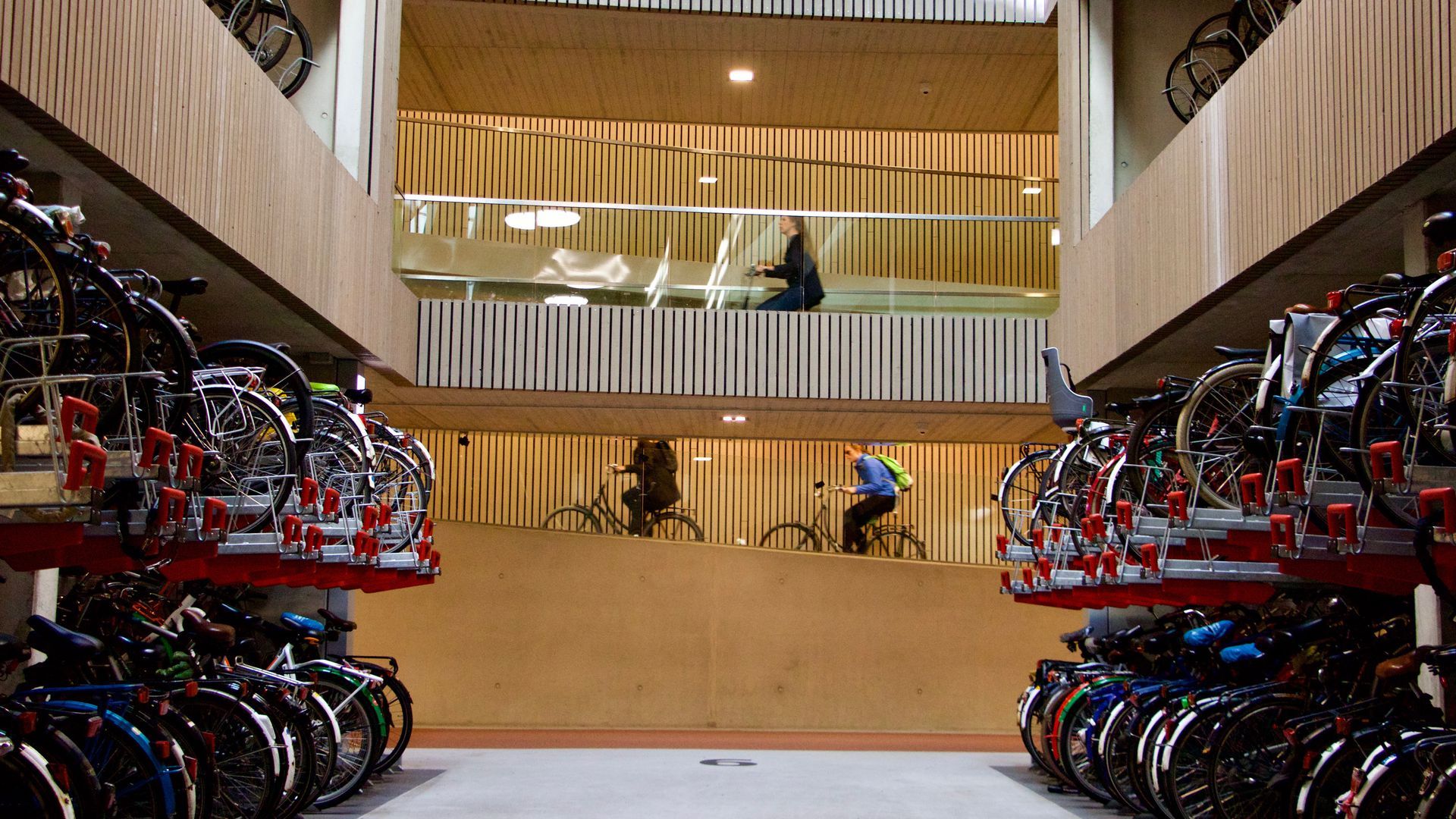| | | | | | | Presented By General Motors | | | | Axios What's Next | | By Bryan Walsh, Erica Pandey and Joann Muller ·Jul 13, 2021 | | Today we're bringing you the young workers who want back in the office, troubles in smart cities and the best place in the world to bike — especially if you happen to be Dutch. "What was next" trivia: On this day in 1977, a major blackout hit what American city? 💡 - Credit to reader Tim Dunaway for being the first to note that the drawing toy that debuted on July 12, 1960 was the immortal Etch-a-Sketch.
- Send your answer, along with tips and feedback, to whatsnext@axios.com.
📻 We're heading to NPR! Join Erica today at 11am ET for the first "What's Next" segment on 1A. Today's Smart Brevity count: 1,221 words ... 4.5 minutes. | | | | | | 1 big thing: Younger workers fear being left behind by remote work |  | | | Illustration: Sarah Grillo/Axios | | | | The post-pandemic working world is rapidly normalizing remote work — but the next generation of workers is wary of the change, writes Erica Pandey. What's happening: Transitioning to remote work is far easier for veteran employees who have already developed social capital in the workplace and know how a company operates. Freshly minted members of the workforce stand to miss out on those valuable skills and opportunities if they can't come back to the office. Driving the news: A whopping 40% of college students and recent graduates prefer fully in-person work, according to a new poll by Generation Lab, a polling and research firm that tracks trends affecting youth. - Another 39% want a hybrid workplace, 19% want to work remotely and 3% say they have no preference.
Why it matters: That's starkly different from the numbers across the rest of the workforce. Just 12% of all office workers want to go back full time, per a recent Slack survey. The rest are looking for a remote or hybrid workplace. When asked what they'll miss in a remote future, 74% of young people say the office community and 41% say mentoring. - 66% of respondents want in-person feedback from their managers, rather than receiving a written report or chatting over Zoom.
- 33% of respondents don't want to miss out on office amenities. The perks at company headquarters — like snacks and gyms — may be disappearing as firms downsize.
Younger workers are likelier than their older colleagues to live in close quarters with roommates or with parents. 45% of respondents say they worry about having access to distraction-free workplaces in a remote or hybrid future. - And older workers have more established personal networks as well, which has made them more able to move away from their workplaces, either to suburbs with nasty commutes or to entirely new cities in anticipation of remote work.
"I like the extra motivation to go home at the end of the day and the ability to separate work life from home life based on place and location," says Jenny Conant, a rising senior at Trinity College in Hartford, Connecticut. It's also easier to read colleagues' body language in-person than online, Conant says. The stakes: "They're missing out on the socialization and the chance to make the contacts and relationships you make in the workplace that lead to other things," says Jeffrey Arnett, a psychologist at Clark University, who coined the term "emerging adults" for 18- to 29-year olds. - Younger workers may get more out of the social component of offices — nearly a quarter of Americans meet their spouses at work — than their older counterparts who may already have families and established networks.
Read the rest. |     | | | | | | 2. Even smart cities are falling short on cybersecurity and inclusion |  | | | Illustration: Rebecca Zisser/Axios | | | | A new report from the World Economic Forum makes the case that even cities that have made the most progress on digital transformation are failing on cybersecurity and technology governance, writes Bryan Walsh. Why it matters: Cities are investing billions in new technologies meant to improve urban life and services. But they're doing too little to keep systems safe from hacking and ensure that all residents can get equal access to the benefits of a smart city. Among the findings: - While the pandemic has accelerated cities' digital transformation, less than half of the cities have policies in place to ensure basic accessibility requirements for smart services.
- Less than a quarter of the cities conduct privacy assessments when they implement new technologies.
- Even as the pandemic has seen an uptick in hacking attacks, most cities do not have anyone specifically designated as accountable for cybersecurity.
- Less than half the cities have a policy in place to install digital infrastructure during construction work, which slows the rollout of needed internet connectivity.
- Just 15% of the cities surveyed have an open data portal for digital city services.
The bottom line: The cities covered in the WEF report are further along than most in digital transformation, which isn't a good sign for the rest of the urban universe. Read the rest. |     | | | | | | 3. Where the tech talent pool is growing |  Data: CBRE; Chart: Will Chase/Axios There are emerging hubs all over the U.S. and Canada pulling tech talent away from the superstar cities — but the tech centers are holding onto their dominance, according to a new analysis from the commercial real estate firm CBRE, writes Erica. The big picture: The pandemic has pushed millions of people to move out of cities, but it hasn't been enough to knock places like the Bay Area and New York out of the top spots to start tech companies. Between the lines: Among the top 10 markets — with tech talent pools well over 150,000 people — the San Francisco and Toronto metro areas have the highest concentration of workers. About 11% of the Bay Area workforce is in tech, and the same is true for Toronto. - Compare that with the 3.8% and 3.7% concentrations in New York and Los Angeles, respectively.
- A high concentration of tech workers can create environments more conducive to innovation, says Colin Yasukochi, executive director of CBRE's tech insights center and author of this report.
Several cities — large and small — saw huge gains in their tech talent pools in the last five years. - Among the big metros, Toronto's pool grew by 43%, Seattle's by 35% and Montreal's by 31%.
- Among the small ones, Orlando, Florida, saw a 30% gain; Nashville, Tennessee, 36%, and Edmonton, Canada, 53%.
Read the rest. |     | | | | | | A message from General Motors | | Progress moves when everybody's in | | |  | | | | General Motors is investing $35 billion globally in EVs and AVs through 2025 and providing access to nearly 60,000 places to charge across the U.S. and Canada. Why it's important: By creating a seamless charging experience, GM's investment is electrifying the future. | | | | | | 4. U.S. cities can learn from Europe on bike friendliness |  | | | The world's largest bike parking garage in Utrecht, Netherlands. Photo by Abdullah Asiran/Anadolu Agency via Getty Images | | | | More Americans have embraced bicycling since the pandemic, but in terms of bike-friendliness, the United States lags far behind Europe, writes Joann Muller. Why it matters: The best cities for bicycling have safe, comfortable and well-connected bike networks, according to People for Bikes, an advocacy group based in Boulder, Colorado. And its new international ranking of bike-friendly cities shows U.S. cities have a lot to learn from their European counterparts. By the numbers: Five of the top 10 cities for bicycling are in the Netherlands, and all but one — Provincetown, Massachusetts — are in Europe. - The top 10 U.S. cities are mostly tourist spots (like Cape Cod's Provincetown) or college towns like Berkeley, California; Boulder, Colorado, and tiny Alma, Michigan.
Details: The rankings of 767 cities in 12 countries are based on a combination of two factors: a network score and a community score. - The network score — which accounts for 80% of a city's overall score — looks at how easily cyclists can get to grocery stores, hospitals, jobs, schools and transit hubs using "low-stress routes" (streets with 25 mph or lower speed limits, or busier streets with protected bike lanes).
- The community score — which accounts for the other 20% — is based on the results of an online survey of bike users.
The top-ranked city on the list is Utrecht, near Amsterdam, where more than one-third of the Dutch city's 360,000 residents commute on bikes. Read the rest. |     | | | | | | 5. Number of the day: 118.1 F |  | | | In Death Valley, California, a sign says it all. Photo: Melina Mara/The Washington Post via Getty Images | | | | That was the average daily temperature recorded in Death Valley, California, on Sunday — the hottest 24-hour average temperature ever observed on the planet, writes Bryan. - The low temperature on Sunday came in at 107.7 F, the highest low ever recorded in North America, while the mercury topped out that day at 128.6 F.
The bottom line: As terrible as Sunday's high temperatures were, the record-high low is arguably even more worrying, and part of a deadly trend of higher overnight temperatures throughout the U.S. |     | | | | | | A message from General Motors | | Progress moves when everybody's in | | |  | | | | General Motors is investing $35 billion globally in EVs and AVs through 2025 and providing access to nearly 60,000 places to charge across the U.S. and Canada. Why it's important: By creating a seamless charging experience, GM's investment is electrifying the future. | | |  | | It'll help you deliver employee communications more effectively. | | | | | | Axios thanks our partners for supporting our newsletters. If you're interested in advertising, learn more here.
Sponsorship has no influence on editorial content. Axios, 3100 Clarendon Blvd, Suite 1300, Arlington VA 22201 | | | You received this email because you signed up for newsletters from Axios.
Change your preferences or unsubscribe here. | | | Was this email forwarded to you?
Sign up now to get Axios in your inbox. | | | | Follow Axios on social media:    | | | | | |









No comments:
Post a Comment